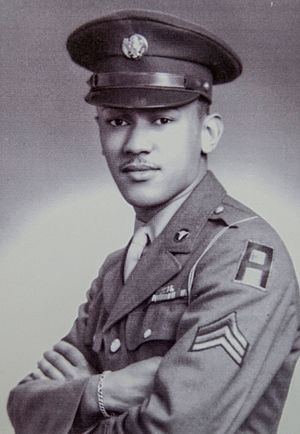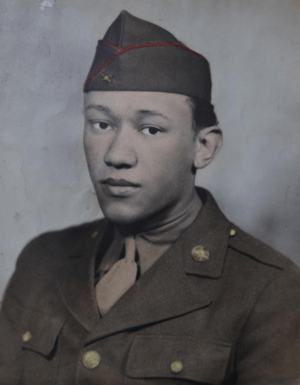Waverly B. Woodson Jr. facts for kids
Quick facts for kids
Waverly Bernard Woodson Jr.
|
|
|---|---|

Woodson's official US Army portrait, taken while he held the rank of sergeant.
|
|
| Nickname(s) | Woody |
| Born | August 3, 1922 Philadelphia, Pennsylvania, U.S. |
| Died | August 12, 2005 (aged 83) Gaithersburg, Maryland, U.S. |
| Buried | |
| Allegiance | |
| Service/ |
|
| Years of service | 1942–1952 |
| Rank | |
| Unit | 320th Barrage Balloon Battalion |
| Battles/wars | World War II |
| Awards | |
| Alma mater | Lincoln University |
| Spouse(s) |
Joann Katharyne Snowden
(m. 1952) |
| Children | 3 |
Waverly Bernard Woodson Jr. (August 3, 1922 – August 12, 2005) was an American soldier and health expert. He is famous for his brave actions as a combat medic during the Battle of Normandy in World War II.
Contents
Waverly Woodson's Early Life
Waverly Bernard Woodson Jr. was born on August 3, 1922. His hometown was Philadelphia, Pennsylvania. After finishing high school, he started college at Lincoln University. He was studying to become a doctor.
Joining the Army and Facing Challenges
When the United States joined World War II, Woodson paused his studies. He joined the United States Army on December 15, 1942. His younger brother, Eugene, joined with him. Woodson did very well on a test. This allowed him to join a special school for officers. He was one of only two African Americans there.
However, Woodson was told he could not become an officer because of his race. Instead, he trained as a combat medic. He was assigned to the 320th Barrage Balloon Battalion. This unit used large balloons to protect against enemy aircraft. During his training, Woodson faced segregation and unfair treatment. By the time of Operation Overlord, he was a corporal.
Hero at D-Day: Omaha Beach
On June 6, 1944, Woodson's unit took part in the Battle of Normandy. This event is also known as D-Day. It was the only African American battalion to be part of the invasion. Because he was a medic, Woodson was on a special boat. This boat was heading to Omaha Beach in the early morning.
As his boat neared the shore, it hit an underwater mine. The boat lost power and drifted to the beach. While drifting, it was hit by an enemy shell. Woodson was hurt by metal pieces in his leg and back. Even though he was injured, he helped set up a first-aid station. He and other medics started treating wounded soldiers.
Woodson worked for 30 hours straight, from 10:00 AM until the next day. He helped many soldiers. He set broken bones, removed bullets, and even removed a foot. He also gave blood plasma to save lives. It is believed that Woodson's actions saved up to 200 soldiers. These soldiers were both black and white.
After his long shift, Woodson was collecting supplies. He then heard that three British soldiers were in trouble. They had been underwater after leaving their boat. Woodson quickly gave them artificial respiration. He helped all three soldiers breathe again and saved them.
Woodson was later taken to a hospital because of his injuries. But after only three days, he asked to go back to the battle. His commanding officer suggested he receive a high award for his bravery. However, Woodson received the Bronze Star Medal and a Purple Heart instead. Many people felt he should have received the highest honor, the Medal of Honor.
After D-Day and Later Life
After the Battle of Normandy, Woodson's unit returned to the U.S. He was moved to the United States Army Reserve in 1945. Woodson wanted to study medicine, but no medical schools would accept him because he was African American. He finished his biology degree at Lincoln University in 1950.
When the Korean War started, the Army called Woodson back. He trained other medics and later managed an Army morgue. He served in several countries, including the United Kingdom and France. He left the Army in 1952 as a staff sergeant.
In 1952, Woodson married Joann Katharyne Snowden. They had three children. After the Army, he worked in health care. He worked at the National Naval Medical Center. Then, he worked at the National Institutes of Health. He managed operating rooms until he retired in 1980.
In 1994, Woodson was invited to France. He visited Normandy to mark 50 years since D-Day. He received a special medal there. Woodson passed away on August 12, 2005, at age 83. He was buried with military honors in Arlington National Cemetery.
Awards and Honors
Waverly Woodson received many awards for his service.
What Awards Did He Receive?
- American Campaign Medal
- Asiatic–Pacific Campaign Medal
- Bronze Star Medal
- European–African–Middle Eastern Campaign Medal with Arrowhead device and two Bronze Stars
- Good Conduct Medal
- Korean Service Medal
- National Defense Service Medal
- Purple Heart
- United Nations Medal
- World War II Victory Medal
A Fight for Greater Recognition
Even with his amazing bravery, Woodson did not receive the Medal of Honor. Many believe this was due to racial discrimination. Also, a fire in 1973 destroyed many Army records. This made it harder to prove his case.
In 2020, a U.S. Senator, Chris Van Hollen, introduced a bill. This bill asked the President to give Woodson the Medal of Honor. Another bill was introduced in the House of Representatives. Woodson's wife, Joann, said she would donate the medal to a museum if he received it. In 2021, a top Army general also supported Woodson getting the Medal of Honor.
Remembering His Legacy
In April 2022, a health clinic was renamed in Woodson's honor. It is now called the Woodson Health Clinic. His son, Stephen, attended the ceremony. He unveiled a portrait of his father.
A character in the 2019 novel Allies by Alan Gratz is based on Waverly Woodson. This helps keep his story alive for new generations.


